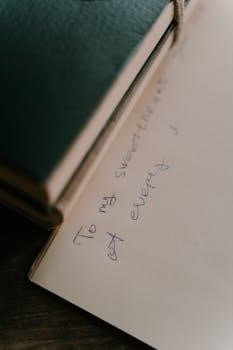The Notebook Movie Script⁚ An Overview
The script for “The Notebook” is available in various formats, including PDF. It details scenes, dialogues, and character actions. The narrative structure is adapted from Nicholas Sparks’ novel, showcasing the love story. The script reveals emotional depth of the characters, especially Allie and Noah, and the challenges they face.
Availability of the Script in PDF Format
Finding the screenplay for “The Notebook” in PDF format is quite feasible through various online resources. Many websites dedicated to screenplays and film scripts offer downloadable versions, often free of charge. These PDFs provide a complete transcription of the movie’s dialogue and scene descriptions, allowing for a detailed analysis of the story’s structure and character interactions. Some script libraries and fan communities also host these documents, making it relatively easy for enthusiasts and students of film to access them. These PDF versions of the script are typically formatted to resemble professional screenplays, including scene headings, character names, and stage directions. The availability of the script in PDF allows for easy sharing and study, facilitating a deeper understanding of the storytelling techniques employed in the movie. This format is particularly useful for those who want to examine the dialogue and pacing of the film at their own convenience. Furthermore, the PDF format is compatible with various devices, including computers, tablets, and smartphones, making it a convenient option for script analysis on the go. It’s important to note that while many legitimate resources offer the script, always ensure that you’re accessing it from a trustworthy source to avoid any potential copyright issues. The ease of availability of the script in PDF format contributes significantly to the film’s accessibility for educational and personal study purposes.

Script Scene Descriptions
The script for “The Notebook” provides detailed scene descriptions, painting a vivid picture of the settings and actions taking place. These descriptions go beyond just stating the location; they often include elements of atmosphere, lighting, and the emotional tone of each scene. For example, the carnival scene where Noah and Allie first meet is described with a focus on the bustling activity and vibrant colors, while scenes at the nursing home where Duke reads to Allie are depicted with a quiet, tender ambiance. The script also details the physical actions of the characters, providing a clear picture of their movements and expressions. These descriptions are crucial in translating the written word into a visual experience for the reader. The scene descriptions also emphasize the differences in social environments, contrasting the wealthy world of Allie with the more humble background of Noah. The script highlights both the youthful exuberance of their initial romance and the quiet intensity of their later years. Details about the old house that Noah dreams of restoring are also prominent, showing its transformation from a dilapidated state into a symbol of his love for Allie. The scene descriptions allow readers to understand the visual language of the film and how each setting contributes to the overarching narrative. The thoroughness in the script ensures that anyone reading it can clearly imagine the visual and emotional impact of each scene.
Character Development in the Script

The script of “The Notebook” meticulously outlines the character development of both Noah and Allie, highlighting their growth throughout the narrative. Initially, Noah is portrayed as a passionate and somewhat rebellious young man, deeply in love with Allie. The script shows how his experiences shape him, from his youthful optimism to the quiet resolve he displays in his later years. Allie, on the other hand, is presented as a sophisticated young woman, bound by societal expectations but drawn to Noah’s free spirit. The script tracks her emotional journey, illustrating her internal conflict between her family’s wishes and her own desires. The script effectively uses dialogue and actions to demonstrate the changes in their personalities and their emotional maturity. As the story progresses, we witness Noah’s unwavering devotion and Allie’s struggle with memory loss, emphasizing their deep bond. The script also carefully develops supporting characters, such as Lon, who represents the societal pressures acting against Noah and Allie’s relationship, further highlighting the obstacles they face. Through these character arcs, the script conveys the complexities of love and commitment. The changes in Noah’s dialogue from youthful exuberance to calm, loving words and Allie’s from free-spirited to unsure and then back again through her recognition of Noah demonstrate how the script portrays the characters’ development.
The Story’s Setting and Time Period
The script of “The Notebook” primarily unfolds in two distinct time periods, creating a rich tapestry of past and present. The main narrative is set in the late 1930s, specifically during a summer in Seabrook, South Carolina, a picturesque coastal town that serves as the backdrop for Noah and Allie’s initial romance. The script vividly depicts the social and economic environment of this era, with its class divisions and societal expectations playing a crucial role in the characters’ lives and decisions. The beautiful beaches and vibrant carnivals mentioned in the script illustrate the carefree spirit of their first summer together. The second time period, much later in the script, is set in a nursing home, where an elderly Noah reads the story of their love to an elderly Allie, who suffers from dementia; This setting provides a poignant contrast to the youthful exuberance of their past, emphasizing the enduring nature of their love through the passage of time. This setting in the script underscores the themes of memory and loss, adding a layer of emotional depth. The use of two distinct settings and time periods helps to highlight the timelessness of their love story and the powerful impact it has had on their lives. The script makes excellent use of these settings to move the story along, with the past informing the present.
The Script’s Adaptation from the Novel
The screenplay for “The Notebook,” adapted from Nicholas Sparks’ novel, meticulously translates the core elements of the book to the screen. The script retains the novel’s dual narrative structure, interweaving the story of the elderly couple in the present with the passionate love affair of their youth. Key plot points are faithfully preserved, including Noah and Allie’s initial meeting at the carnival, their summer romance, and the societal pressures that threaten to tear them apart. The script also highlights the novel’s poignant themes of enduring love, memory, and the effects of time. While some minor details might be altered or condensed for cinematic purposes, the adaptation successfully captures the emotional essence of the original story. The character arcs of Noah and Allie, their deep connection, and the obstacles they face are all well-represented in the script. The script also uses dialogue to bring the characters to life, retaining the novel’s powerful emotional impact. The script’s adaptation also brings to life the settings, making the story feel real and authentic. In the end, the screenplay works to bring a beloved novel to life, preserving its key components and themes.

Key Dialogue Exchanges

The script of “The Notebook” is replete with key dialogue exchanges that define the characters and propel the narrative forward. One such exchange occurs when Noah confronts Allie about her engagement to Lon, showcasing his raw emotions and unwavering love. Their passionate arguments reveal the depth of their feelings and the obstacles they must overcome. Another pivotal conversation centers on Noah’s declaration of love, “It wasn’t over, it still isn’t over,” which encapsulates the film’s central theme of enduring love. These exchanges are not merely plot devices; they offer insights into the characters’ internal conflicts and motivations. The script also employs dialogue to establish the contrast between the young and older versions of Allie and Noah, highlighting the timeless nature of their bond. The dialogue also serves to convey the emotional intensity of the story, enhancing its impact on the audience. The conversations between Noah and Allie showcase the development of their relationship, from their first meeting at the carnival to their later reunions. These dialogues are essential to the film’s emotional resonance and its enduring appeal.
The Script’s Narrative Structure
The narrative structure of “The Notebook” script is characterized by a dual timeline, skillfully weaving together the past and present. The story unfolds through the eyes of an elderly man, Duke, who reads from a notebook to an elderly woman with dementia, creating a frame narrative that enhances the emotional impact. The script smoothly transitions between the younger Noah and Allie’s passionate romance in the 1930s and their elderly counterparts in a nursing home. The use of flashbacks allows the audience to witness the evolution of their love story while simultaneously experiencing the poignant reality of their present circumstances. This structure not only generates suspense but also adds a layer of melancholy and reflection to the narrative. The script uses these narrative shifts to highlight the enduring power of love and memory. The present-day narrative serves to frame the past, emphasizing the timelessness of their bond. The script’s structure enhances the themes of love, loss, and remembrance, and its seamless integration of past and present strengthens the film’s emotional resonance.
Comparisons with the Film
Comparing “The Notebook” script to the final film reveals several interesting adaptations and interpretations. The script provides the foundational framework for the movie, but the film brings it to life with visual elements, music, and the actors’ performances. While the script describes scenes and dialogues, the film adds nuances through cinematography, set design, and the emotional expressions of the characters. The script might contain extended scenes or dialogues that were cut or condensed for pacing in the film. Certain visual elements and moments of silence in the film were created based on the script but are not explicitly detailed in it. The actors’ interpretation of the characters can also add layers that go beyond the script’s literal descriptions. The film’s soundtrack plays a significant role in enhancing the emotional impact, which is not present in the script, obviously. Therefore, while the script serves as a blueprint, the film uses cinematic tools to elevate the story and make it a different experience. The film builds upon the script, bringing the written word into a visual and auditory experience.
Finding the Script Online
Locating “The Notebook” script online can be achieved through various methods. Many websites dedicated to screenplays offer downloadable PDF versions of movie scripts. These sites often have a search function to find specific titles. Additionally, some fan forums and communities might share script documents, sometimes as part of study or discussion groups. It’s important to verify the source’s reliability when downloading scripts, as some files might not be accurate or complete. Screenwriting resources and educational websites may also host script PDFs as study materials. It’s essential to ensure that the script is the correct version, as there may be different drafts available. Some sites provide access to the script with a free registration or account, while others may require a small fee or subscription. Be aware of copyright laws when downloading and using scripts; they are often for personal and educational purposes only. Checking multiple sources may help in finding the most accurate version of “The Notebook” script. Utilizing search engines with specific keywords can refine results.
Analysis of the Script’s Emotional Impact
The emotional impact of “The Notebook” script is profound, largely due to its exploration of enduring love and loss. The script effectively captures the intense emotions between Noah and Allie, highlighting their passionate connection and the obstacles they face. Dialogue and scene descriptions are carefully crafted to elicit strong feelings in the reader. The portrayal of their youthful romance is contrasted with the challenges of their later years, creating a poignant and heart-wrenching experience. The script masterfully employs narrative devices to build emotional tension, leading to moments of great joy and sorrow. The use of flashbacks and the framing device of the nursing home story add layers of emotional depth to the narrative. The script’s success lies in its ability to evoke empathy for the characters and their struggles. It explores universal themes of love, commitment, and memory loss, resonating with a wide audience. The script’s focus on the power of love in the face of adversity is a recurring element, adding to its emotional resonance. The overall effect is a deeply moving portrayal of human emotions.
Impact on the Film’s Success
The script of “The Notebook” played a crucial role in the film’s success by providing a solid foundation for the narrative and emotional core. The adaptation from the novel effectively translated the love story into a screenplay that resonated with audiences. The script’s careful character development allowed the actors to bring Noah and Allie to life in a compelling way. The dialogue was crafted to capture the essence of their relationship, both in its passionate youth and in its tender later years. The structure of the script, with its use of flashbacks and the framing device of the nursing home, created a compelling narrative that kept viewers engaged. The emotional depth of the script, particularly in its exploration of enduring love and the challenges of memory loss, was crucial to the film’s overall impact. The script’s ability to evoke strong emotions contributed significantly to the film’s popularity. The successful translation of the source material ensured that the film captured the spirit of the novel. The script provided a roadmap for the film that allowed the director, actors, and other creatives to successfully tell the story.
